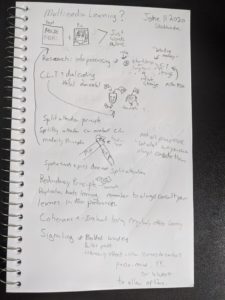Which multimedia learning (MML) principles did Dr. Ray Pastore not follow in his video about MML principles?
The first Principle that Dr. Pastore did not follow was the redundancy principle. I noted this at the 27-second mark when he was saying what was written precisely on the slide behind him. The redundancy principle was not displayed because the principle states that “People learn better when the same information is not presented in more than one format” (Mayer 2014). Dr. Pastore was presenting the same information in 2 formats simultaneously.
Additional principles that Dr. Pastore did not follow are the segmenting and pre-training principles. The principles support the theory that “People learn better when a multimedia message is presented in learner-paced segments rather than as a continuous unit, people learn better from a multimedia message when they know the names and characteristics of the main concepts” (Mayer 2014). They were not followed in the video because Dr. Pastore covered a wide range of topics quickly in one continuous video. He did not establish that learners had the prerequisite knowledge. However, this video is an intro to some of these topics, so in the context of our EDCI 337 class, the use of this video by Rich McCue is following the principles.
Why might an expert not be able to follow all the principles when creating a multimedia learning object?
An expert, such as Dr. Pastore, may not be able to follow every single principle 100% of the time because many of the principles are contradictory. A principle like the redundancy principle can work against another principle, such as the multiple representational principles. Another example of this can be seen by examining the drawing principle in contrast to the working memory principle and can be taken further by applying the split-attention theory to this. A teacher must be aware of the principles but has also to consider their overall pedagogy and the individuality of their students and the diversity that inevitably will exist in group settings.
Which learning principles would a thoughtfully created H5P interactive video take advantage of or demonstrate?
The H5P tool supports virtually all of the principles related to multimedia learning. Two examples are the feedback principle and the segmenting principle. The feedback principle can be supported by placing questions into a video that informs students if they answer the question correctly. The segmenting principle can be supported by putting pauses in the video and using a caption to highlight certain aspects of the learning process and thus segmenting it.
Could you see yourself using H5P in your practice? If so, how might you be able to use it appropriately for the learners at the grade level you’re teaching to support a pedagogy you are using?
Not only can I see myself using H5P in my practice, but I am also excited to do so! I feel that it is essential to keep the cognitive abilities of the learners in mind when using H5P. For example, using cartoon images as pop-ups in a video can be effective with younger children, whereas complementary test bubbles or questions will be more productive with middle-schoolers. Here is a youtube video that I enhanced using H5P.
Other thoughts or reflections on interactive and multimedia learning from any of these topics, videos, readings, and H5P lab?
I have tried to use sketchnoting as a study aid in each section of this course. I have included a picture of a small page of sketchnotes I did concerning this topic.
References
Mayer, R. E. (2014). Introduction to Multimedia Learning1. In the Cambridge handbook of multimedia learning (pp. 1–14). New York: Cambridge University Press.

Leave a Reply